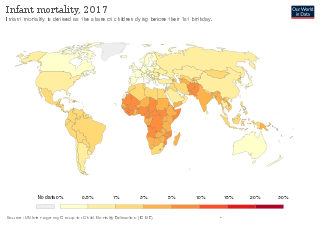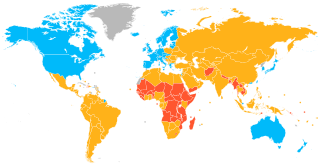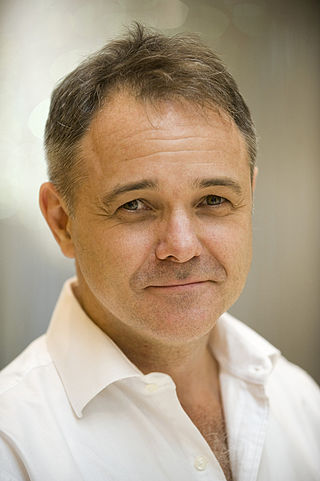Related Research Articles

Tuberculosis (TB) is an infectious disease usually caused by Mycobacterium tuberculosis (MTB) bacteria. Tuberculosis generally affects the lungs, but it can also affect other parts of the body. Most infections show no symptoms, in which case it is known as latent tuberculosis. Around 10% of latent infections progress to active disease which, if left untreated, kill about half of those affected. Typical symptoms of active TB are chronic cough with blood-containing mucus, fever, night sweats, and weight loss. It was historically referred to as consumption due to the weight loss associated with the disease. Infection of other organs can cause a wide range of symptoms.

Infant mortality is the death of an infant before the infant's first birthday. The occurrence of infant mortality in a population can be described by the infant mortality rate (IMR), which is the number of deaths of infants under one year of age per 1,000 live births. Similarly, the child mortality rate, also known as the under-five mortality rate, compares the death rate of children up to the age of five.

A developing country is a sovereign state with a lesser developed industrial base and a lower Human Development Index (HDI) relative to other countries. However, this definition is not universally agreed upon. There is also no clear agreement on which countries fit this category. The terms low and middle-income country (LMIC) and newly emerging economy (NEE) are often used interchangeably but refers only to the economy of the countries. The World Bank classifies the world's economies into four groups, based on gross national income per capita: high, upper-middle, lower-middle, and low income countries. Least developed countries, landlocked developing countries and small island developing states are all sub-groupings of developing countries. Countries on the other end of the spectrum are usually referred to as high-income countries or developed countries.
Women's health differs from that of men in many unique ways. Women's health is an example of population health, where health is defined by the World Health Organization as "a state of complete physical, mental and social well-being and not merely the absence of disease or infirmity". Often treated as simply women's reproductive health, many groups argue for a broader definition pertaining to the overall health of women, better expressed as "The health of women". These differences are further exacerbated in developing countries where women, whose health includes both their risks and experiences, are further disadvantaged.
Tropical diseases are diseases that are prevalent in or unique to tropical and subtropical regions. The diseases are less prevalent in temperate climates, due in part to the occurrence of a cold season, which controls the insect population by forcing hibernation. However, many were present in northern Europe and northern America in the 17th and 18th centuries before modern understanding of disease causation. The initial impetus for tropical medicine was to protect the health of colonial settlers, notably in India under the British Raj. Insects such as mosquitoes and flies are by far the most common disease carrier, or vector. These insects may carry a parasite, bacterium or virus that is infectious to humans and animals. Most often disease is transmitted by an insect bite, which causes transmission of the infectious agent through subcutaneous blood exchange. Vaccines are not available for most of the diseases listed here, and many do not have cures.

Tropical medicine is an interdisciplinary branch of medicine that deals with health issues that occur uniquely, are more widespread, or are more difficult to control in tropical and subtropical regions.

Global health is the health of the populations in the worldwide context; it has been defined as "the area of study, research, and practice that places a priority on improving health and achieving equity in health for all people worldwide". Problems that transcend national borders or have a global political and economic impact are often emphasized. Thus, global health is about worldwide health improvement, reduction of disparities, and protection against global threats that disregard national borders, including the most common causes of human death and years of life lost from a global perspective.
The European and Developing Countries Clinical Trials Partnership (EDCTP) is a partnership between the European Union (EU), Norway, Switzerland and developing countries and other donors, as well as the pharmaceutical industry, to enable clinical trials and the development of new medicines and vaccines against HIV/AIDS, tuberculosis, and malaria. The need for global action against these diseases in order to promote poverty reduction has been recognised by the United Nations, the G8, and the African Union, and the program envisioned the provision of €600 million for the period 2003–2007 in order to translate medical research results into clinical applications relevant to the needs of developing countries.
Enterotoxigenic Escherichia coli (ETEC) is a type of Escherichia coli and one of the leading bacterial causes of diarrhea in the developing world, as well as the most common cause of travelers' diarrhea. Insufficient data exists, but conservative estimates suggest that each year, about 157,000 deaths occur, mostly in children, from ETEC. A number of pathogenic isolates are termed ETEC, but the main hallmarks of this type of bacterium are expression of one or more enterotoxins and presence of fimbriae used for attachment to host intestinal cells. The bacterium was identified by the Bradley Sack lab in Kolkata in 1968.
Diseases of poverty are diseases that are more prevalent in low-income populations. They include infectious diseases, as well as diseases related to malnutrition and poor health behaviour. Poverty is one of the major social determinants of health. The World Health Report (2002) states that diseases of poverty account for 45% of the disease burden in the countries with high poverty rate which are preventable or treatable with existing interventions. Diseases of poverty are often co-morbid and ubiquitous with malnutrition. Poverty increases the chances of having these diseases as the deprivation of shelter, safe drinking water, nutritious food, sanitation, and access to health services contributes towards poor health behaviour. At the same time, these diseases act as a barrier for economic growth to affected people and families caring for them which in turn results into increased poverty in the community. These diseases produced in part by poverty are in contrast to diseases of affluence, which are diseases thought to be a result of increasing wealth in a society.

The Drugs for Neglected Diseases initiative (DNDi) is a collaborative, patients' needs-driven, non-profit drug research and development (R&D) organization that is developing new treatments for neglected diseases, notably leishmaniasis, sleeping sickness, Chagas disease, malaria, filarial diseases, mycetoma, paediatric HIV, cryptococcal meningitis, hepatitis C, and dengue. DNDi's malaria activities were transferred to Medicines for Malaria Venture (MMV) in 2015.

Neglected tropical diseases (NTDs) are a diverse group of tropical infections that are common in low-income populations in developing regions of Africa, Asia, and the Americas. They are caused by a variety of pathogens, such as viruses, bacteria, protozoa, and parasitic worms (helminths). These diseases are contrasted with the "big three" infectious diseases, which generally receive greater treatment and research funding. In sub-Saharan Africa, the effect of neglected tropical diseases as a group is comparable to that of malaria and tuberculosis. NTD co-infection can also make HIV/AIDS and tuberculosis more deadly.
The Access to Medicine Index is a ranking system published biennially since 2008 by the Access to Medicine Foundation in Amsterdam, the Netherlands, an international not-for-profit organisation, funded by the Dutch Ministry of Foreign Affairs, the UK Foreign, Commonwealth, and Development Office (FCDO), the Bill & Melinda Gates Foundation, Wellcome Trust, and Axa Investment Managers. It ranks the world's 20 largest pharmaceutical companies according to their ability to make their pharmaceutical drugs more available, affordable, accessible and acceptable in 106 low- to middle-income countries. The biennial index aims to stimulate industry to improve access in developing countries, to show the activities of their peers, and allow them, governments, investors, civil society, patient organisations and academia to gather and form a common view of how pharmaceutical companies can make further progress.

Sir Jeremy James Farrar is a British medical researcher who has served as chief scientist at the World Health Organization since 2023. He was previously the director of the Wellcome Trust from 2013 to 2023 and a professor of tropical medicine at the University of Oxford.
Access to medicines refers to the reasonable ability for people to get needed medicines required to achieve health. Such access is deemed to be part of the right to health as supported by international law since 1946.
Sabin Vaccine Institute (Sabin), located in Washington, D.C., is a nonprofit organization promoting global vaccine development, availability, and use. Through its work, Sabin hopes to reduce human suffering by preventing the spread of vaccine-preventable, communicable disease in humans through herd immunity and mitigating the poverty caused by these diseases.

Animal vaccination is the immunisation of a domestic, livestock or wild animal. The practice is connected to veterinary medicine. The first animal vaccine invented was for chicken cholera in 1879 by Louis Pasteur. The production of such vaccines encounter issues in relation to the economic difficulties of individuals, the government and companies. Regulation of animal vaccinations is less compared to the regulations of human vaccinations. Vaccines are categorised into conventional and next generation vaccines. Animal vaccines have been found to be the most cost effective and sustainable methods of controlling infectious veterinary diseases. In 2017, the veterinary vaccine industry was valued at US$7 billion and it is predicted to reach US$9 billion in 2024.
The European Vaccine Initiative (EVI) is a non-profit Product Development Partnership (PDP) with the goal of supporting and accelerating the development of effective and affordable vaccines for global health. Since its inception in 1998, EVI has operated as an independent non-profit organisation that works closely with academic researchers, the private sector, governments, and other organisations to spearhead vaccine development. Headquartered in Heidelberg, Germany, EVI collaborates with partners across the world to pursue its mission.
Tuberculosis elimination is the effort to reduce the number of tuberculosis (TB) cases to less than one per 1 million population, contrasted with the effort to completely eradicate infection in humans worldwide. The goal of tuberculosis elimination is hampered by the lack of rapid testing, short and effective treatment courses, and completely effective vaccine. The WHO as well as the Stop TB Partnership aim for the full elimination of TB by 2050—requiring a 1000-fold reduction in tuberculosis incidence. As of 2017, tuberculosis has not been eliminated from any country.
The Kigali Declaration on Neglected Tropical Diseases is a global health project that aims to mobilise political and financial resources for the control and eradication of infectious diseases, the so-called neglected tropical diseases due to different parasitic infections. Launched by the Uniting to Combat Neglected Tropical Diseases on 27 January 2022, it was the culmination and join commitment declared at the Kigali Summit on Malaria and Neglected Tropical Diseases (NTDs) hosted by the Government of Rwanda at its capital city Kigali on 23 June 2022.
References
- ↑ "10/90 gap". Global Forum for Health Research. 2011. Retrieved April 16, 2015.[ permanent dead link ]
- ↑ Luchetti, M. (2014). Global health and the 10/90 gap. British Journal of Medical Practitioners, 7(4), 4.
- 1 2 3 Currat, L.J., Francisco, A., Al-Tuwaijri, S., Ghaffar, A., & Jupp, S. (2004). 10/90 report on health research 2003-2004. WHO Drug Information, 18(3), 243. Retrieved from http://announcementsfiles.cohred.org/gfhr_pub/assoc/s14789e/s14789e.pdf
- ↑ Hotez P.J.; Ferris M.T. (2006). "The antipoverty vaccines". Vaccine. 26 (24): 5787–5799. doi:10.1016/j.vaccine.2006.05.008. PMID 16759763.
- ↑ Haines, A., Kuruvilla, S., & Borchert, M. (2004). Bridging the implementation gap between knowledge and action for health. Bulletin of the World Health Organization, 82(10), 724–732.
- ↑ Kilama W. L. (2009). "The 10/90 gap in sub-saharan africa: Resolving inequities in health research". Acta Tropica. 112: S8–S15. doi:10.1016/j.actatropica.2009.08.015. PMID 19695211.
- ↑ Stevens, Philip (2004). Diseases of Poverty and the 10/90 Gap. London, UK.: International Policy Network. pp. 7–8.
- ↑ Hunter, D.J.; Reddy, K.S. (2013). "Global health: Noncommunicable diseases". The New England Journal of Medicine. 369 (14): 1336–1343. doi: 10.1056/NEJMra1109345 . PMID 24088093.
- ↑ Luchetti, Marco (2014). "Global Health and the 10/90 gap". British Journal of Medical Practitioners. ISSN 1757-8515. Archived from the original on 2015-03-26. Retrieved 10 April 2015.
- ↑ World Health Organization (2001). Macroeconomics and Health: Investing in Health for Economic Development . Geneva: World Health Organization. pp. 7–11. ISBN 9789241545501.
- ↑ Moon, Suerie (15 May 2012). "Innovation and Access to Medicines for Neglected Populations: Could a Treaty Address a Broken Pharmaceutical R&D System?". PLOS Medicine. 9 (5): e1001218. doi: 10.1371/journal.pmed.1001218 . PMC 3352855 . PMID 22615544.
- ↑ Liese, Bernhard H; Houghton, Natalia; Teplitskaya, Lyubov (2014). "Development assistance for neglected tropical diseases: Progress since 2009". International Health. 6 (3): 162–171. doi: 10.1093/inthealth/ihu052 . PMID 25096331.
- 1 2 Vidyasagar, D (2006). "Global notes: The 10/90 gap disparities in global health research". Journal of Perinatology. 26 (1): 55–56. doi:10.1038/sj.jp.7211402. PMID 16281051. S2CID 31057013.